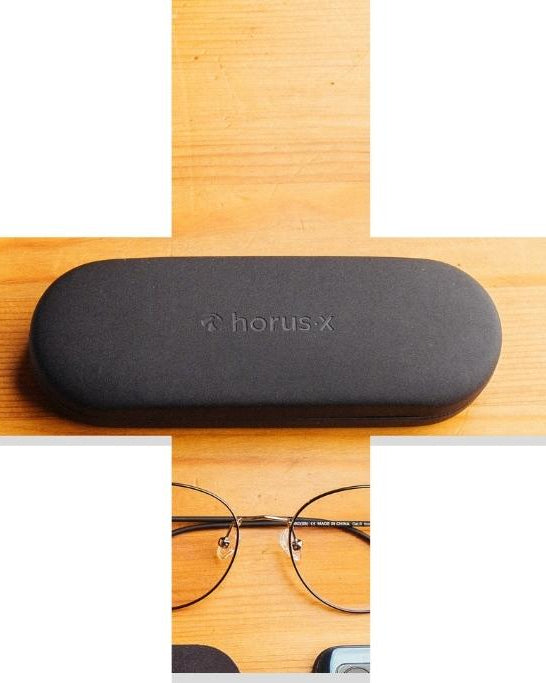You just left the eye doctor’s office and the verdict is clear: you need glasses to fix your vision problems. But before rushing to the optician to pick out your new specs, you probably want to know if you can get reimbursed or if it’s time to break open your savings jar. No surprises here, glasses can be pricey, so it’s smart to be well-informed about reimbursements.
What’s the basic reimbursement rate for glasses through health insurance? How much will your private insurance cover? What exactly does it include? We’ve put together a complete guide to answer all your questions about getting your corrective (or non-corrective) lenses covered!
How does glasses reimbursement work with Social Security?

This article explains how eyewear reimbursements work in France and is based on the French healthcare and insurance system.
Let’s start at the beginning: before even checking your private insurance’s reimbursement rates for optical costs, let’s talk about the basic reimbursement from public health insurance.
Public health insurance will cover part of the costs linked to your glasses (frames and lenses) if you have a prescription. This means you need a valid prescription from an eye doctor detailing your vision correction to qualify. We won’t sugarcoat it — Social Security reimbursement for glasses is pretty low, and there’s often a significant out-of-pocket expense (that’s where good private insurance comes in, which we’ll talk about next).
For adults, here are the basic reimbursement amounts from public health insurance (60% on a fixed rate):
- Frames: base price €0.05, reimbursement €0.03.
- Simple lenses: base price €2.29, reimbursement €1.37 per lens.
- Complex lenses: base price between €3.66 and €4.36, reimbursement €2.19 to €2.61 per lens.
- Progressive or multifocal lenses: base up to €6.71 per lens, reimbursement up to €4.02.
For kids, it’s a bit better:
- Frames: based on a price of €30.49, reimbursement around €18.29.
- Simple lenses: based on €12.04 per lens, reimbursement €7.22.
- Complex lenses: based on prices between €16.42 and €25.50, reimbursement between €9.85 and €15.30.
- Multifocal lenses: base price between €33.60 and €66.62, reimbursement €20.16 to €39.97.
Note: These amounts are current as of June 2025 and may change with new policies or rate adjustments.
💡 Good to know: your prescription must be less than 5 years old (if you’re between 16 and 42; it’s 1 year if younger and 3 years if older). Your new glasses must be purchased from an authorized retailer. For replacement glasses, adults (16+) must wait 2 years and children under 16 between 6 months and 1 year, unless your prescription changes or you have a specific condition.
Spotlight on the 100% Health coverage scheme

As you can see, public health insurance won’t cover much of your glasses purchase. But since January 2020, thanks to the “100% Health” scheme, it’s possible to get glasses without any out-of-pocket expense.
Basically, this means choosing frames and lenses with capped prices, called the “100% Health basket”. The cost is split between public insurance and your private insurance, which covers the rest.
Here’s how reimbursement caps break down:
- Frames: optician’s selection under €30
- Simple single-vision lenses: up to €95 per lens
- Complex single-vision lenses: up to €265 per lens
- Simple progressive lenses: up to €180 per lens
- Complex progressive lenses: up to €370 per lens
Heads up: to fully benefit, you need private insurance with a “responsible contract” compatible with this scheme. Public insurance won’t cover everything, so you’ll still need to pay the difference if your private insurance doesn’t cover the rest.
Private insurance: how do optical health plans work?

As the name suggests, private insurance plans are there to top up the reimbursements from Social Security.
The level of reimbursement depends on your plan, so take your time to compare policies based on your needs.
You’ll find this info in your insurance contract, which will detail specific coverage amounts, often expressed in euros, as an annual allowance or a fixed budget for optical care.
We know, it’s confusing and dull — but super important. Check the reimbursement rates or amounts for different lens types and frames, as well as whether there’s a contact lens allowance if you need one.
As mentioned above, since the 100% Health scheme started, private insurers must offer a fully reimbursed option with no out-of-pocket costs. You can also choose to mix: pick the basic basket for some parts and upgrade others (usually the lenses), paying the difference yourself.
💡 Tip: 100% Health is different from direct billing, which means you don’t pay upfront before reimbursement at the optician. For that, your optician and insurer both have to support it (and be partners, which isn’t always the case). If your costs go beyond your coverage, you’ll still have to dig into your wallet.
Glasses, lenses, frames: reimbursement overview for major insurers
| Insurer | Monthly Premium (€) | Frames (€) | Simple lenses (€) | Complex lenses (€) | Very complex lenses (€) | Notes |
| SwissLife | 39-203 | 100 | 200 | 480 | 680-800 | Ideal for progressive lenses or strong prescriptions. Itelis network. |
| Apivia Macif (Senior plan) | 80-206 | 100 | 500 | 800 | - | Good coverage for complex lenses. Designed for 55+. |
| April Santé Prévoyance | 48-160 | 100 | 400 | 600 | - | Good value for money. Partner optician network. |
| Mutuelle Générale | 37-160 | 100 | 250 | 350 | 450 | Standard cover with some direct billing options. |
| Harmonie Mutuelle | 30-110 | 80 | 350 | 550 | 650 | Competitive rates, good for families. |
Note: The above amounts are annual reimbursements and can vary depending on your contract and location.
How to Get Reimbursed for Your Eyewear Expenses?

First things first, if you can get an estimate from your optician to send to your insurance before buying, that’s a smart move—it helps you know exactly what’s covered.
When it comes to reimbursement, it all depends on how your health insurance (aka your "mutual") works and which optician you choose. Here are the usual scenarios:
- Full direct billing: If your optician does direct billing with your insurance, you won’t have to pay anything upfront, or maybe just a small leftover amount. Your public health system and your insurance sort out the payments directly—so you can just sit back and relax!
- Network of providers: If your optician is part of your insurance’s preferred provider network, you’ll usually get better reimbursements, capped prices, and sometimes even direct billing. This can save you some hassle and cash. Major insurers with such networks include folks like Blue Cross Blue Shield, UnitedHealthcare, Aetna, Cigna, and Humana.
- No direct billing or out-of-network optician: If your optician doesn’t do direct billing or isn’t in your insurer’s network, you’ll have to pay upfront and then submit your receipts and a valid prescription to your insurance for reimbursement. You can usually do this online or by mail.
- Buying glasses online: Yes, you can get reimbursed for glasses bought online as well, as long as you have a valid prescription and an invoice. Just keep in mind there’s usually no direct billing here. Also, some approved sites offer "100% health" plans with no out-of-pocket expenses on certain glasses.
Do Insurance Plans Cover Sunglasses or Blue Light Glasses?

If you’ve made it this far, you’re basically an expert on eyeglass reimbursement! But what about sunglasses, contact lenses, and those trendy blue light blockers? Let’s break it down.
Are Sunglasses Covered by Insurance?
Generally, insurance doesn’t cover sunglasses, even if they have prescription lenses. Exceptions exist though—if your eye doctor prescribes them for specific medical conditions like keratitis, photokeratitis, light sensitivity, or after refractive surgery, you might be in luck.
What About Contact Lenses?
Cosmetic or comfort contact lenses aren’t reimbursed by public health or private insurers.
But some medically necessary contact lenses (for corneal malformations or strong prescriptions) can be reimbursed by public health with a doctor’s prescription.
Your insurance may cover prescription lenses depending on your plan, usually offering a yearly allowance between $100 and $300.
Quick Tip: Blue Light Glasses Reimbursement
Regarding the question Are blue light glasses reimbursed? the answer is simple: nope, at least not by public health.
Your insurance might cover anti-reflective or blue light treatments on your prescription lenses if included in your plan, but honestly, given the quality of filters nowadays, you might want to shop around.
If you don’t need prescription lenses, it’s a good idea to pick solid blue light glasses (or even gaming glasses) with a good price-to-quality ratio. Word on the street is you’ll find some gems on our shop!
If you do need prescription lenses, we’ve got you covered too. Our prescription blue light glasses have been approved by a trusted optician and certified by an independent lab as a Class 1 medical device. They might qualify for reimbursement under your insurance’s second-pair, prevention, or special optical allowances. Just like regular glasses: add up the total cost and check it against your insurance’s yearly limit before buying. To be 100% sure, don’t hesitate to message your insurance contact—they’ll confirm the details.
The Bottom Line: What You Need to Know About Getting Your Glasses Covered
- Corrective glasses are barely covered by public health insurance (think a couple bucks for frames and a few bucks per lens depending on complexity). So it’s worth picking a good private plan.
- Your private insurance, as the name suggests, will top up what public health covers. Amounts vary by plan—take your time comparing what fits your needs.
- Key things to check in your optical insurance plan: reimbursement caps, how often you can renew, amounts covered for frames and lenses by category, coverage for lens treatments, and whether there’s an allowance for contacts or a second pair. Also check if your insurer has a provider network, offers direct billing, and how they handle paperwork.
- How to get reimbursed? If your optician and insurance do direct billing, you’re all set with no upfront payments. If not, you’ll need to submit your prescription (valid for 5 years if you’re 16-42, 3 years if older than 42, and 1 year for kids) and receipt. This also applies to online purchases (with or without “100% health” coverage if the site is approved).
- For sunglasses, most insurance plans don’t cover them. For contacts, you might get a yearly allowance.
- Blue light glasses? Not covered either, usually. But some insurers offer allowances if you get prescription blue light lenses. Definitely worth asking about!
















